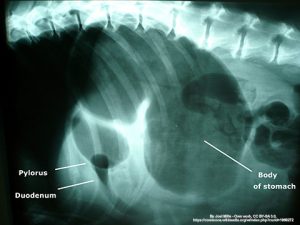There is a wide range of unpleasant and even fatal diseases that dogs are prone to. For some of these (such as cancer, pancreatitis, or arthritis), there is relatively little we can do to prevent our pets from developing a disease. However, for many infectious diseases, there is a preventative measure that all dog owners can take that is incredibly safe and effective – vaccination. 
What diseases are we talking about here?
There are a wide range of infectious diseases in dogs for which there are vaccines. In general, these are divided into ‘Core’ and ‘Non-Core’ groups.
The Core Vaccines are those which protect against diseases that cause severe suffering (and often death). Every dog should be vaccinated against these diseases:
- Distemper – this disease is closely related to measles and causes severe respiratory and intestinal damage; it also causes damage to the eyes and brain. Overall, the mortality rate is roughly 50%. Cases of Distemper have been rising in some regions such as Kent.
- Canine Infectious Hepatitis – this virus attacks the liver and kidneys, and again is potentially fatal.
- Canine Parvovirus – a particularly nasty infection, in that it primarily targets young puppies (although any dog is potentially at risk). The virus essentially destroys the gut lining and then attacks the immune system. While early, aggressive treatment may reduce the mortality rate to about 15%, any delay results in this rising rapidly – in severe outbreaks, where emergency veterinary hospitalisation and intensive care isn’t available, as many as 90% of infected puppies may die.
- Leptospirosis. Leptospirosis is a bacterial infection that is carried by rats and excreted in their urine (a closely related strain of the disease is carried by cows). Dogs can pick up Leptospirosis from mud, ponds and waterways and cases have recently risen in the UK.
Unlike most of the other diseases above, it can also infect humans and we can be infected from our pets. In the UK, Leptospirosis is endemic – meaning that rats carrying it live all across the mainland UK, and every dog is potentially at risk. As a result, we do strongly recommend that your dog is vaccinated against this nasty disease, which attacks the kidneys, gut and occasionally liver. Until recently, this was relatively rarely diagnosed in the UK – because of effective vaccination! However, there are now new strains of the disease emerging, and, as a result, we’ve now moved to a more modern vaccine that targets all four strains of the disease rather than the traditional two.
The Non-Core vaccines are those which aren’t strictly needed by every dog – they are available, but how important they are will depend on your dog’s lifestyle and where you live (or travel to!). They include:
- Canine Parainfluenza and Bordetella bronchiseptica – the most effective and commonly used vaccine is a combined intranasal, or ‘up the nose’ vaccine. These are two of the most important causes of Kennel Cough, a nasty but not usually dangerous infection of the voicebox and windpipe. Vaccination is advised for all dogs that are likely to be socialising with other dogs and is an essential requirement for most kennels.
- Rabies – essential if you wish to travel abroad and avoid quarantine; otherwise, not really necessary in the UK!
- Lyme Disease – a new vaccine, most appropriate for dogs who spend a lot of time in high-tick areas (e.g. the moors of western England and Wales).
Why can’t we let our dogs’ immune systems deal with these diseases?
All of the Core diseases are potentially fatal. This is because unvaccinated dogs need to learn how to fight the disease before they can defeat it. If they’re unlucky, or the disease is a particularly aggressive strain, or their immune system makes a mistake (which is common!), the infection may prove fatal before the immune system can mount an effective response.
What is a vaccine?
A vaccine is essentially a way to teach the immune system how to fight an infection without actually subjecting the animal to the dangerous version of the infectious organism. Different vaccines last for different lengths of time – for example, the Distemper, Parvo and Rabies vaccines need to be given twice to a puppy, then one year later, and then only every 3 years to be effective. On the other hand, the Lepto vaccine needs 2 puppy doses and then annual vaccination for life, otherwise the immunity fades away.
Aren’t vaccines dangerous?
In a word, no – not compared to the diseases they prevent. The only common side-effect is some sleepiness for 24 hours or so after the injections.
Are they 100% safe? No – any medicine that actually works will have some potential side effects. However, major side effects are extremely rare, and lack of vaccination is both dangerous and irresponsible. It is true that some pets get away without being vaccinated – mainly because the immunity of the other dogs in the population suppresses these dangerous infections, so the unvaccinated dogs are unlikely to be exposed (called ‘herd immunity’). But, if everyone stopped vaccinating, the diseases would make a comeback, like the Welsh Distemper outbreak a few years ago which killed 4 dogs.
If you want to discuss your dog’s vaccines, please contact one of us in practice!




